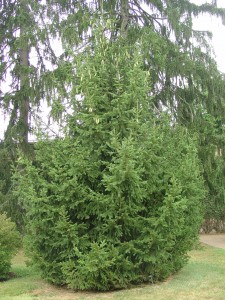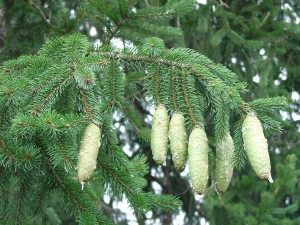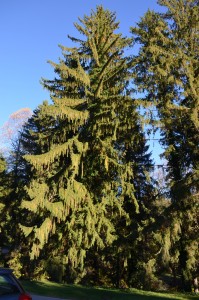Norway spruce (Picea abies) is a large pyramidal evergreen conifer. It is native to the mountains of northern and central Europe where it often matures to 100 feet or more in height. In the cool temperate areas of the U.S. and Canada, Norway spruce is widely planted, typically reaching 50 to 80 feet tall at maturity (USDA hardiness zones 2 to 7-a).
Norway spruce prefers a moist, mildly acidic, well-drained soil and in full sun. The species thrives in the mountains of northeast Tennessee and southwest North Carolina (zone 6 and 7-a), but fails in middle TN and eastern NC (7-b).
Annual growth rate is rapid. Main branches are turned slightly upright on the ends and secondary branches are drooping (pendulous), more apparent on mature trees. Branches are clad with four-sided medium green needles that are spirally arranged along branches. Needles are soft to grip. It is often mistaken for Colorado spruce (P. pungens), whose bluish green needles are right angled and sharp to the touch. Cylindrical seed bearing cones, 5 – 9 inches long, are pendulous. Sticky resin frequently coats the bark of trunk and main branches.
Norway spruce is not troubled by serious insect or disease problems when properly sited. Several species of mites may plague individual spruce trees from time to time. Deer usually stay away from most needle conifers. Birds make use of the layered branches for shelter from wind and cold and as a haven from predators.
Norway spruce is commonly planted in parks, large properties, and woodland areas. It is also utilized as a tall privacy screen, windbreak, or for erosion control. As many as 150 tree and shrub cultivars of Norway spruce are available. Dwarf, upright and weeping forms are set before building foundations and rock garden plantings. It is used as a cut Christmas tree, but needle retention is short-lived.




 Posted in
Posted in 
